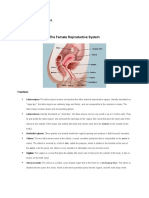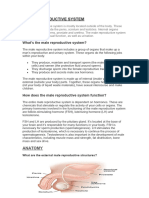Penis: This Is The Male Organ Used in Sexual Intercourse. It Has Three Parts: The Root, Which Attaches To The Wall of The
Penis: This Is The Male Organ Used in Sexual Intercourse. It Has Three Parts: The Root, Which Attaches To The Wall of The
Uploaded by
Anonymous fI3rSoCopyright:
Available Formats
Penis: This Is The Male Organ Used in Sexual Intercourse. It Has Three Parts: The Root, Which Attaches To The Wall of The
Penis: This Is The Male Organ Used in Sexual Intercourse. It Has Three Parts: The Root, Which Attaches To The Wall of The
Uploaded by
Anonymous fI3rSoOriginal Title
Copyright
Available Formats
Share this document
Did you find this document useful?
Is this content inappropriate?
Copyright:
Available Formats
Penis: This Is The Male Organ Used in Sexual Intercourse. It Has Three Parts: The Root, Which Attaches To The Wall of The
Penis: This Is The Male Organ Used in Sexual Intercourse. It Has Three Parts: The Root, Which Attaches To The Wall of The
Uploaded by
Anonymous fI3rSoCopyright:
Available Formats
Penis: This is the male organ used in sexual intercourse.
It has three parts: the root, which attaches to the wall of the
abdomen; the body, or shaft; and the glans, which is the cone-shaped part at the end of the penis. The glans, also
called the head of the penis, is covered with a loose layer of skin called foreskin. This skin is sometimes removed in a
procedure called circumcision. The opening of the urethra, the tube that transports semen and urine, is at the tip of
the penis. The glans of the penis also contains a number of sensitive nerve endings.The body of the penis is cylindrical
in shape and consists of three circular shaped chambers. These chambers are made up of special, sponge-like tissue.
This tissue contains thousands of large spaces that fill with blood when the man is sexually aroused. As the penis fills
with blood, it becomes rigid and erect, which allows for penetration during sexual intercourse. The skin of the penis is
loose and elastic to accommodate changes in penis size during an erection.Semen, which contains sperm
(reproductive cells), is expelled (ejaculated) through the end of the penis when the man reaches sexual climax
(orgasm). When the penis is erect, the flow of urine is blocked from the urethra, allowing only semen to be ejaculated
at orgasm.Scrotum: This is the loose pouch-like sac of skin that hangs behind and below the penis. It contains the
testicles (also called testes), as well as many nerves and blood vessels. The scrotum acts as a "climate control system"
for the testes. For normal sperm development, the testes must be at a temperature slightly cooler than body
temperature. Special muscles in the wall of the scrotum allow it to contract and relax, moving the testicles closer to
the body for warmth or farther away from the body to cool the temperature.Testicles (testes): These are oval organs
about the size of large olives that lie in the scrotum, secured at either end by a structure called the spermatic cord.
Most men have two testes. The testes are responsible for making testosterone, the primary male sex hormone, and for
generating sperm. Within the testes are coiled masses of tubes called seminiferous tubules. These tubes are
responsible for producing sperm cells.Epididymis: The epididymis is a long, coiled tube that rests on the backside of
each testicle. It transports and stores sperm cells that are produced in the testes. It also is the job of the epididymis to
bring the sperm to maturity, since the sperm that emerge from the testes are immature and incapable of fertilization.
During sexual arousal, contractions force the sperm into the vas deferens.Vas deferens: The vas deferens is a long,
muscular tube that travels from the epididymis into the pelvic cavity, to just behind the bladder. The vas deferens
transports mature sperm to the urethra, the tube that carries urine or sperm to outside of the body, in preparation for
ejaculation.Ejaculatory ducts: These are formed by the fusion of the vas deferens and the seminal vesicles (see
below). The ejaculatory ducts empty into the urethra.Urethra: The urethra is the tube that carries urine from the
bladder to outside of the body. In males, it has the additional function of ejaculating semen when the man reaches
orgasm. When the penis is erect during sex, the flow of urine is blocked from the urethra, allowing only semen to be
ejaculated at orgasm.Seminal vesicles: The seminal vesicles are sac-like pouches that attach to the vas deferens
near the base of the bladder. The seminal vesicles produce a sugar-rich fluid (fructose) that provides sperm with a
source of energy to help them move. The fluid of the seminal vesicles makes up most of the volume of a man's
ejaculatory fluid, or ejaculate.Prostate gland: The prostate gland is a walnut-sized structure that is located below the
urinary bladder in front of the rectum. The prostate gland contributes additional fluid to the ejaculate. Prostate fluids
also help to nourish the sperm. The urethra, which carries the ejaculate to be expelled during orgasm, runs through the
center of the prostate gland.Bulbourethral glands: Also called Cowper's glands, these are pea-sized structures
located on the sides of the urethra just below the prostate gland. These glands produce a clear, slippery fluid that
empties directly into the urethra. This fluid serves to lubricate the urethra and to neutralize any acidity that may be
present due to residual drops of urine in the urethra.Labia majora: The labia majora enclose and protect the other
external reproductive organs. Literally translated as "large lips," the labia majora are relatively large and fleshy, and
are comparable to the scrotum in males. The labia majora contain sweat and oil-secreting glands. After puberty, the
labia majora are covered with hair.Labia minora: Literally translated as "small lips," the labia minora can be very
small or up to 2 inches wide. They lie just inside the labia majora, and surround the openings to the vagina (the canal
that joins the lower part of the uterus to the outside of the body) and urethra (the tube that carries urine from the
bladder to the outside of the body).Bartholin's glands: These glands are located beside the vaginal opening and
produce a fluid (mucus) secretion.Clitoris: The two labia minora meet at the clitoris, a small, sensitive protrusion that
is comparable to the penis in males. The clitoris is covered by a fold of skin, called the prepuce, which is similar to the
foreskin at the end of the penis. Like the penis, the clitoris is very sensitive to stimulation and can become
erect.Vagina: The vagina is a canal that joins the cervix (the lower part of uterus) to the outside of the body. It also is
known as the birth canal.Uterus (womb): The uterus is a hollow, pear-shaped organ that is the home to a developing
fetus. The uterus is divided into two parts: the cervix, which is the lower part that opens into the vagina, and the main
body of the uterus, called the corpus. The corpus can easily expand to hold a developing baby. A channel through the
cervix allows sperm to enter and menstrual blood to exit.Ovaries: The ovaries are small, oval-shaped glands that are
located on either side of the uterus. The ovaries produce eggs and hormones.Fallopian tubes: These are narrow
tubes that are attached to the upper part of the uterus and serve as tunnels for the ova (egg cells) to travel from the
ovaries to the uterus. Conception, the fertilization of an egg by a sperm, normally occurs in the fallopian tubes. The
fertilized egg then moves to the uterus, where it implants into the lining of the uterine wall.
You might also like
- Star Wars - D20 - Alien AnthologyDocument135 pagesStar Wars - D20 - Alien Anthologykensai106693% (14)
- 4444vyuggewdffv PDFDocument1 page4444vyuggewdffv PDFMi-sun ParkNo ratings yet
- Reproductive SystemDocument2 pagesReproductive SystemA.S.A. QuerubinNo ratings yet
- The Female Reproductive System: Niegas, Eunice Ida Marie A. BSN 1-ADocument3 pagesThe Female Reproductive System: Niegas, Eunice Ida Marie A. BSN 1-AEunice Ida Marie NiegasNo ratings yet
- The Male Reproductive SystemDocument4 pagesThe Male Reproductive SystemHoney MalabuteNo ratings yet
- Male Reproductive System and Female Reproductive SystemDocument2 pagesMale Reproductive System and Female Reproductive SystemChristian Ezekiel LagmayNo ratings yet
- Reproductive SystemDocument4 pagesReproductive SystemShekinah AsebuqueNo ratings yet
- Penis Abdomen Skin CircumcisionDocument6 pagesPenis Abdomen Skin CircumcisionYolandhea Firdanasari FirdausNo ratings yet
- Male RepDocument3 pagesMale RepAdaha AngelNo ratings yet
- Understanding The Human Sexual ResponseDocument12 pagesUnderstanding The Human Sexual ResponseMaan JosueNo ratings yet
- Male Reproductive SystemDocument8 pagesMale Reproductive SystemkcNo ratings yet
- Reproductive SystemDocument2 pagesReproductive SystemJason TaburnalNo ratings yet
- SG 5 Anaphy ActivityDocument4 pagesSG 5 Anaphy Activitykim christianNo ratings yet
- Understanding The SelfDocument4 pagesUnderstanding The SelfBeverly ZarsueloNo ratings yet
- Oleza Cannery S. Reproductive SystemDocument16 pagesOleza Cannery S. Reproductive SystemCannery OlezaNo ratings yet
- BIO 222 Male and Female Reproductive System - 080723Document15 pagesBIO 222 Male and Female Reproductive System - 080723BamideleNo ratings yet
- Female and Male Reproduvtive SytemDocument4 pagesFemale and Male Reproduvtive SytemAndreiNo ratings yet
- Bio InfoDocument5 pagesBio InfoSoham MultaniNo ratings yet
- Anatomy and Physiology of Male Reproductive SystemDocument4 pagesAnatomy and Physiology of Male Reproductive SystemNicole Anne TungolNo ratings yet
- Bio MalesDocument2 pagesBio MalesTrann TtuyetNo ratings yet
- Reproductive System ReportDocument18 pagesReproductive System ReportminnieNo ratings yet
- Human Male Reproductive SystemDocument2 pagesHuman Male Reproductive Systemmilviepaz100% (1)
- Biomedicalperspective in Gender and Sexuality: Anatomy and Physiology of ReproductionDocument29 pagesBiomedicalperspective in Gender and Sexuality: Anatomy and Physiology of ReproductionBrian CastañedaNo ratings yet
- Human Reproductive SystemDocument3 pagesHuman Reproductive SystemBalolot RalphNo ratings yet
- Science Presentation: By: Beam BorachoDocument33 pagesScience Presentation: By: Beam BorachoPEMAR ACOSTANo ratings yet
- Female Reproductive System: Anatomy and PhysiologyDocument2 pagesFemale Reproductive System: Anatomy and PhysiologyRyan MulanoNo ratings yet
- Reproductive sy-WPS OfficeDocument5 pagesReproductive sy-WPS OfficeAngelo NolealNo ratings yet
- Penis: Abdomen Skin CircumcisionDocument4 pagesPenis: Abdomen Skin CircumcisionTatadarz Auxtero LagriaNo ratings yet
- The Male Reproductive SystemDocument3 pagesThe Male Reproductive SystemJOEL BALAJADIANo ratings yet
- Science 10Document4 pagesScience 10Dawn April sanoyNo ratings yet
- Dana AssignmentDocument10 pagesDana AssignmentDana khalidNo ratings yet
- Human Reproductive System Stem 11Document9 pagesHuman Reproductive System Stem 11Ivy Ann P. VillarinNo ratings yet
- Parts of The Male Reproductive SystemDocument2 pagesParts of The Male Reproductive SystemEris MolenoNo ratings yet
- SXSXDocument27 pagesSXSXJoevany E. BigorniaNo ratings yet
- Female Reproductive SystemDocument2 pagesFemale Reproductive SystemJohn Paulo Morales50% (2)
- Male Repro SystemDocument21 pagesMale Repro Systemdoreen03No ratings yet
- The Reproductive SystemDocument17 pagesThe Reproductive SystemRye ManosNo ratings yet
- Week 4Document158 pagesWeek 4Qossay WaxNo ratings yet
- HistologyDocument6 pagesHistologyarezoo bahramiNo ratings yet
- Reproductive SystemDocument34 pagesReproductive Systemsyifa alawiyahNo ratings yet
- Internal Male AnatomyDocument1 pageInternal Male AnatomybabyNo ratings yet
- Internal Male AnatomyDocument1 pageInternal Male AnatomybabyNo ratings yet
- Reviewer Sa ScienceDocument15 pagesReviewer Sa Sciencecjosh9975No ratings yet
- Anatomy of The Male Reproductive SystemDocument8 pagesAnatomy of The Male Reproductive SystemSejuta AdaNo ratings yet
- Male ReproductiveDocument15 pagesMale ReproductiveJanna Izabelle Morales TorralbaNo ratings yet
- Anatomy - The Reproductive SystemDocument37 pagesAnatomy - The Reproductive Systemhdavoudi7No ratings yet
- What Is The Male Reproductive SystemDocument7 pagesWhat Is The Male Reproductive SystemAbrar AhmadNo ratings yet
- The Human Reproductive System: By: Blessing Guzman & Jay MerilanDocument14 pagesThe Human Reproductive System: By: Blessing Guzman & Jay MerilanMark Anthony Evangelista CabrietoNo ratings yet
- Anatomy and PhysiologyDocument29 pagesAnatomy and PhysiologyAngela RosidoNo ratings yet
- Male Reproductive ReportDocument9 pagesMale Reproductive ReportLeilla Mae PataNo ratings yet
- Reproductive Science 10Document22 pagesReproductive Science 10palicpicbea50No ratings yet
- Reproductive SystemDocument10 pagesReproductive SystemKian Paul ClaroNo ratings yet
- Male ReproductiveDocument9 pagesMale ReproductiveanneNo ratings yet
- Male Anatomy DefinitionsDocument1 pageMale Anatomy Definitionsapi-284262659No ratings yet
- Gender & Society Lo4Document6 pagesGender & Society Lo4Mark Eugene DeocampoNo ratings yet
- Anatomy and Physiology of The Male and Female Reproductive System Female Reproductive Anatomy and PhysiologyDocument6 pagesAnatomy and Physiology of The Male and Female Reproductive System Female Reproductive Anatomy and PhysiologyJustJ ThingsNo ratings yet
- Thereproductivesystem 120510015854 Phpsystemsapp02Document68 pagesThereproductivesystem 120510015854 Phpsystemsapp02Rodel AgapitoNo ratings yet
- Male Reproductive SystemDocument8 pagesMale Reproductive SystemShayu ShaNo ratings yet
- The Human Male Reproductive SystemDocument20 pagesThe Human Male Reproductive System7f29hxf2ncNo ratings yet
- The Penis, Function, Diseases, A Simple Guide To The Condition, Diagnosis, Treatment And Related ConditionsFrom EverandThe Penis, Function, Diseases, A Simple Guide To The Condition, Diagnosis, Treatment And Related ConditionsNo ratings yet
- SchistosomiasisDocument4 pagesSchistosomiasisLeo TiuNo ratings yet
- Tropocells 4 Pages PDF Format January 2011Document4 pagesTropocells 4 Pages PDF Format January 2011robertoblumandradeNo ratings yet
- Pelvic and PerineumDocument20 pagesPelvic and PerineumRahaf MajadlyNo ratings yet
- Abe151 AssDocument5 pagesAbe151 AssReanna TabujaraNo ratings yet
- Taisachmoi Tu Vung Tieng Han Bang Hinh AnhDocument116 pagesTaisachmoi Tu Vung Tieng Han Bang Hinh AnhNguyễn Ngọc Quỳnh 3H-20No ratings yet
- Mutant Future Creatures of The Tropical WastesDocument64 pagesMutant Future Creatures of The Tropical WastesMike Mitchell100% (2)
- УточкиDocument13 pagesУточкиLa Casa De Matilda100% (2)
- 3 - The KhasisDocument24 pages3 - The KhasisBobby JNo ratings yet
- Sefer ShedimDocument32 pagesSefer ShedimKNUP TFADNo ratings yet
- Read The Selection and Answer Each Question. Visit Florida Caverns State ParkDocument6 pagesRead The Selection and Answer Each Question. Visit Florida Caverns State ParkReham NabilNo ratings yet
- Body Awareness Alignment Breath MechanismDocument11 pagesBody Awareness Alignment Breath MechanismcheshiecNo ratings yet
- Important Questions For CBSE Class 8 English Honeydew Chapter 6 - This Is Jody's FawnDocument5 pagesImportant Questions For CBSE Class 8 English Honeydew Chapter 6 - This Is Jody's FawnShamsher Singh ChopraNo ratings yet
- Gr8 Jainisam Colour Science On NavkarmantraDocument3 pagesGr8 Jainisam Colour Science On Navkarmantraniks2010No ratings yet
- 4 Sesión Feminist Poems. A SelectionDocument24 pages4 Sesión Feminist Poems. A SelectionVivianaUrbanejaNo ratings yet
- Antler 217 November A4Document12 pagesAntler 217 November A4The AntlerNo ratings yet
- Idioms and Phrases2Document6 pagesIdioms and Phrases2Ravi PrakashNo ratings yet
- Afs Assignment 1Document8 pagesAfs Assignment 1AarthiNo ratings yet
- AGR355 - Chapter 35a - The Poultry IndustryDocument6 pagesAGR355 - Chapter 35a - The Poultry Industryiryne ChessNo ratings yet
- Reichenbach Letters On Od and Magnetism PDFDocument63 pagesReichenbach Letters On Od and Magnetism PDFGerard Mulot0% (1)
- g1 To 5 Basic Vocabulary Spelling ListDocument8 pagesg1 To 5 Basic Vocabulary Spelling ListCita CitaNo ratings yet
- F3 Maseno School End Year ExamsDocument306 pagesF3 Maseno School End Year Examsbosiboribeatrice25No ratings yet
- Tommy Scales DAKDocument1 pageTommy Scales DAKLaura RicoNo ratings yet
- The Importance of PhotosynthesisDocument2 pagesThe Importance of PhotosynthesissamahaseNo ratings yet
- English Grade 5Document117 pagesEnglish Grade 5Diaz Nuaj100% (3)
- Five Minute Tests Unit 5Document5 pagesFive Minute Tests Unit 5mitio pishtovaNo ratings yet
- How To Measure Water Holding CapacityDocument2 pagesHow To Measure Water Holding CapacitymichabcdeNo ratings yet
- Michael J. Hathaway, Animal As Historical Actors. Southwest China's Wild Elephants and Coming To Know The Worlds They ShapeDocument11 pagesMichael J. Hathaway, Animal As Historical Actors. Southwest China's Wild Elephants and Coming To Know The Worlds They ShapeRidlo IlwafaNo ratings yet
- Dear MR KilmerDocument9 pagesDear MR KilmerJonny HengNo ratings yet

























































































